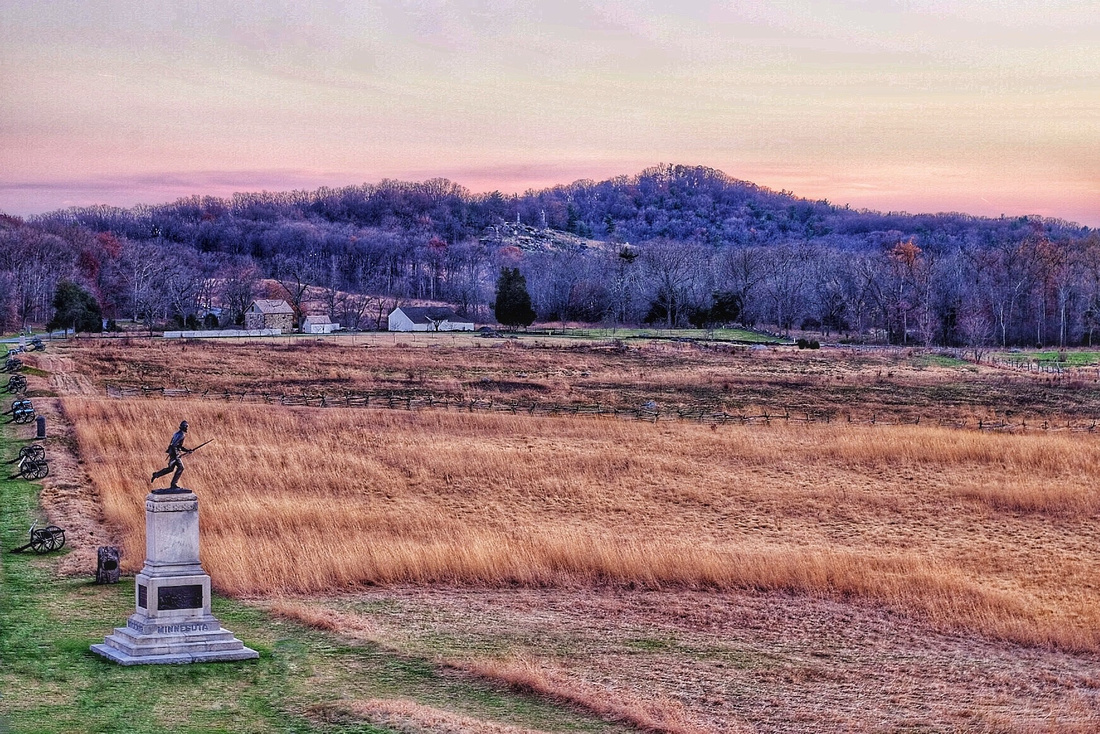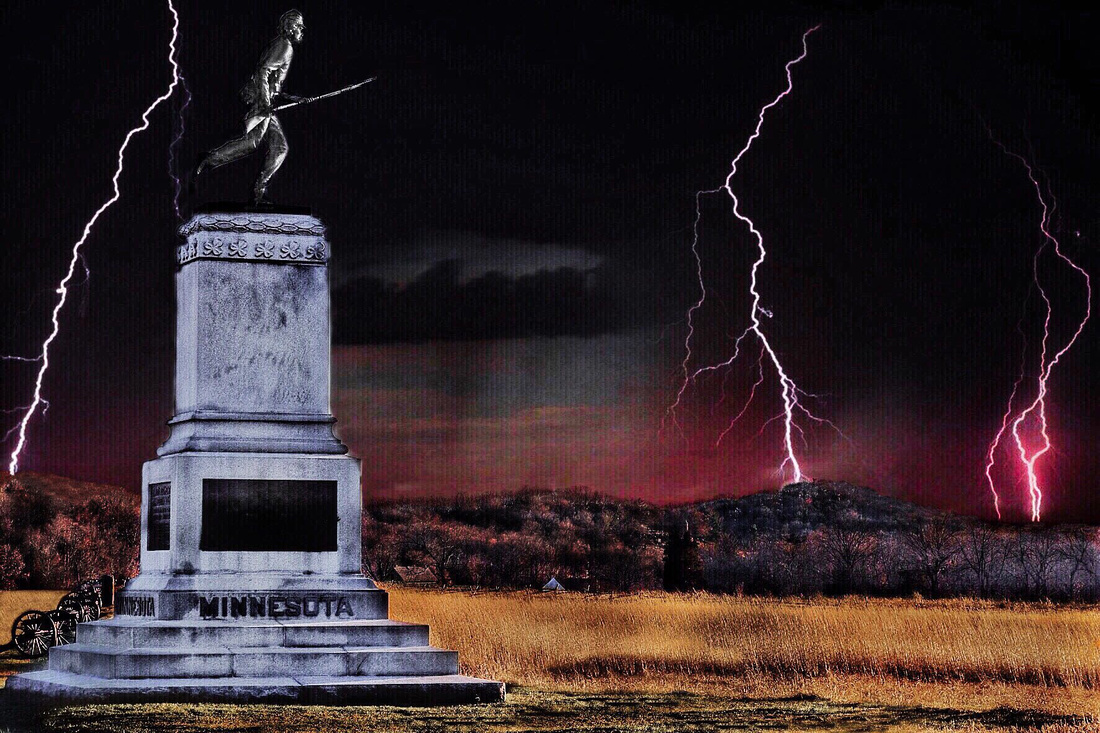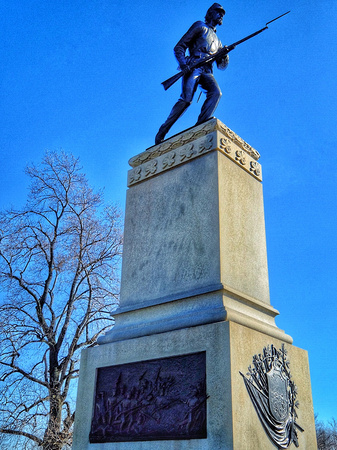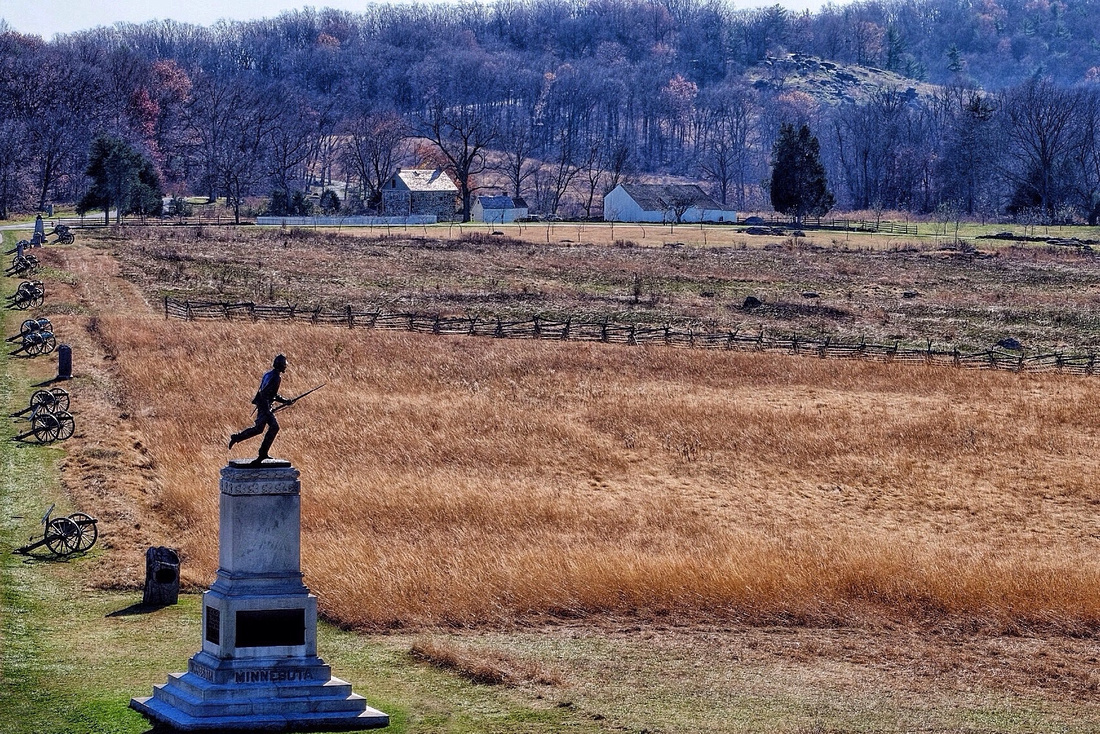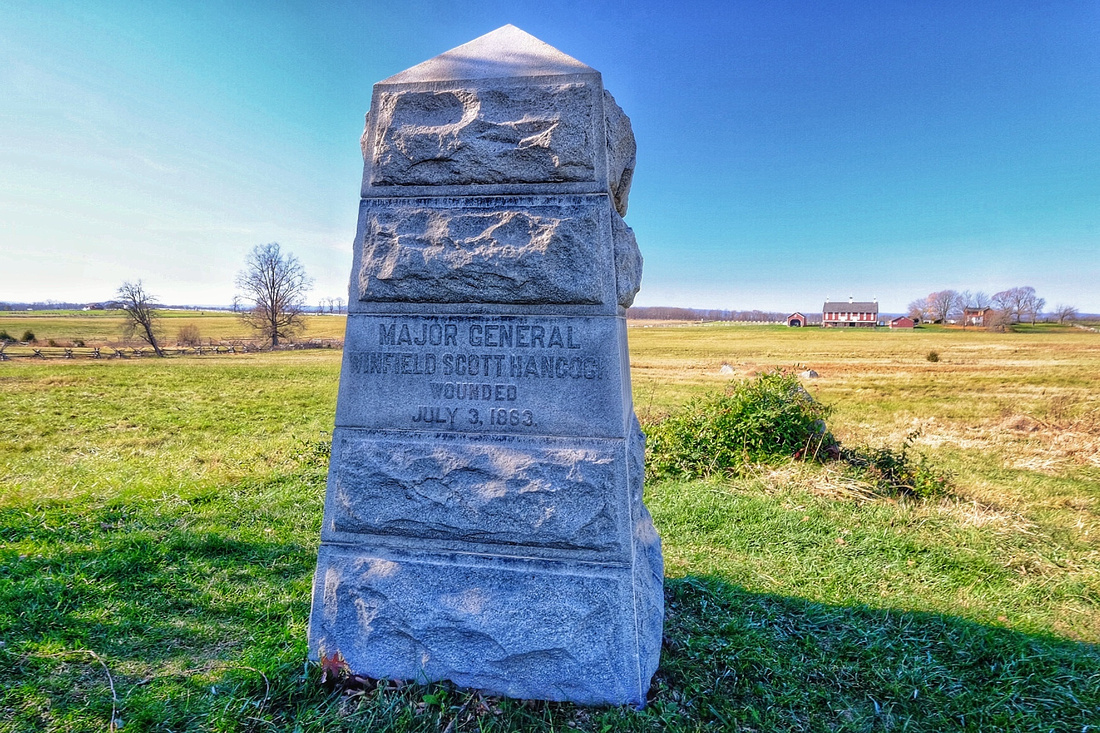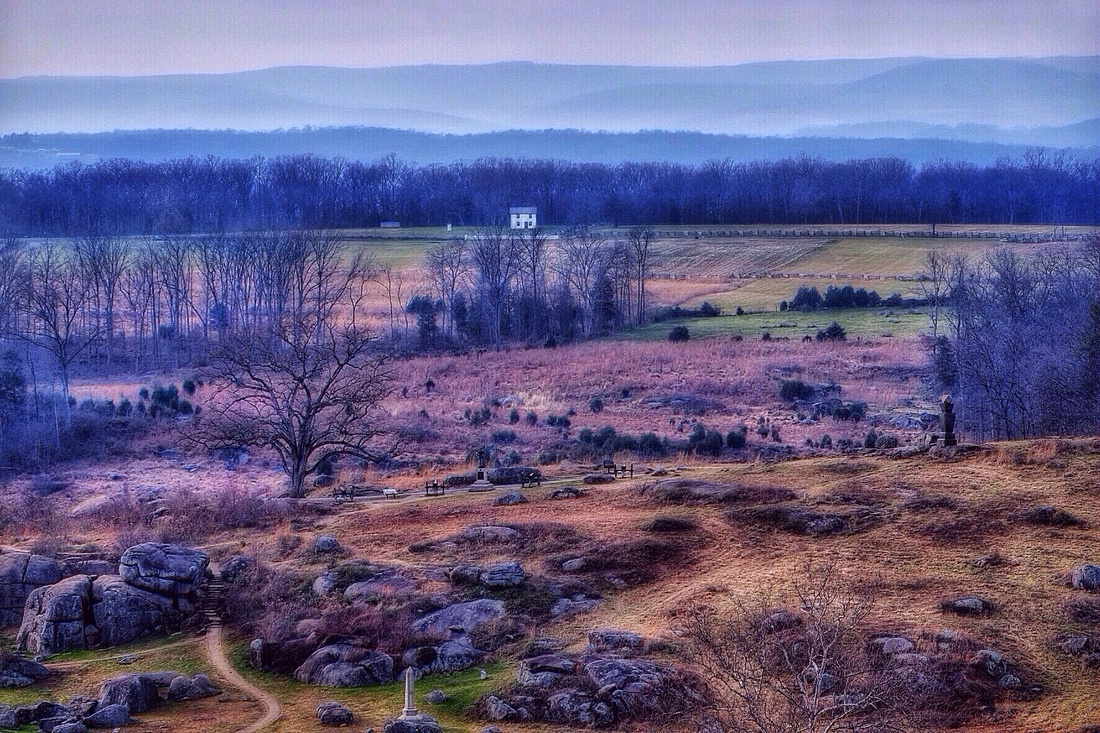The Bravery at Gettysburg
General Cadmus M. Wilcox watched with pride as his Alabaman soldiers made their way down the slope toward a dry creek bed known locally as Plum Run. The Yankee-blue line was rapidly disintegrating before them and fleeing to Cemetery Hill where only Union artillery lay poised to defend the last stand of General Meade's Army of the Potomac (AOP). But suddenly, through the smoky gunpowder haze, emerged about three hundred brave northern soldiers, bayonets leveled and charging with a vengeance directly at the swell of men from the Southland. These were the 1st Minnesotans! Moments before, General Winfield Hancock had observed from horseback the retreat of General Sickles' Third Corps from the Peach Orchard salient as General Wilcox's and General Barksdale's troops rolled like an unstoppable tidal wave of butternut headed for the heights of Cemetery Ridge and victory.1 From Cemetery Ridge, Sergeant Alfred Carpenter of the 1st Minnesota watched the Third Corps fall back and observed:
"Back over the plain they came, slowly, not faster than a walk, loading as they came and every now and then turning and pouring a deadly volley into the foe. The Rebs came in two splendid lines, firing as they advanced ... The plain was strewed with dead and wounded. The Rebs had advanced their batteries and were hurling death and destruction into the ranks of our retreating men ... The stragglers came rushing through the lines, whom we in vain tried to stop and at last gave it up entirely, believing they were more injury than help to us. Now and then shells fell uncomfortably near us."
At this critical and pivotal moment of the day two Battle of Gettysburg, Hancock rode up to the Minnesotans, the only available nearby troops2, and asked Colonel William Colvill, "My God, are these all the men we have here?". After Colvill identified his command, Hancock then pointed to the rapidly approaching Rebels and ordered Colvill to "Advance Colonel, and take those colors!". Hancock later recalled: "I saw that in some way five minutes must be gained or we were lost." Lieutenant William Lochran, later wrote that,
"Every man realized in an instant what that order meant -- death or wounds to us all; the sacrifice of the regiment to gain a few minutes' time and save the position, and probably the battlefield."
Colvill then commanded, "Attention, First Minnesota, right shoulder shift; Arms. Forward, double quick march!" The eight companies of the 1st Minnesota regiment immediately marched down the Cemetery Hill slope and then gallantly charged over about 350 yards through a wheat field stubble to Plum Run, where outnumbered by about 5 to 1, they encountered the heavy fire of Wilcox's 1,500 Alabamans. Sergeant Alfred Carpenter wrote later that:
"Bullets whistled past us, shells screeched over us; canister and grape fell about us........Comrade after comrade dropped from the ranks; but on the line went. No one took a second look at his fallen companion. We had no time to weep."
Another regimental soldier recalled:
"It seemed as if every step was over some fallen comrade. Yet no man wavers, every gap is closed up ... bringing down their bayonets, the boys press forward in unbroken line. Men stumbled and fell. Some stayed down but others got up and continued."
As Wilcox's men crossed the dry creek bed and started up the victory slope to Cemetery Hill, Corvill ordered a volley fire 30 paces from the faces of the Rebels. Corvill then yelled "Charge!" and his men leveled their bayonets at the first line of Wilcox which recoiled back into the rear line with much confusion and disorder.3 The sudden attack by the First shocked the two lines of Alabamans and caused them to fall back across Plum Run and back some distance up the opposite slope. One officer from the First said that "men were never made who will stand against leveled bayonets coming with such momentum and evident desperation." Colvill, expecting a counterattack, ordered his men to take cover along the shallow banks of Plum Run. Continuous and heavy gunfire was exchanged with the Rebs at a respectful distance for many minutes from both the front line and flanks of the First. But the now cautious Wilcox had not yet ordered a counterattack. The First could not hold its position much longer, but at this point, the Minnesotans had bought the AOP not only the five minutes Hancock needed, but an additional ten minutes beyond that. With only moments to spare, the First was reinforced on the left flank with troops from the 111th NY regiment (Willard's Brigade) that were ordered in by General Hancock. Wilcox was forced to break off any planned attack and return to the Emmitsburg Road. The day was saved, but just barely.
This charge of "forlorn hope" bought the time needed for Hancock to send in the brigade of Colonel Willard4 to subdue the advance of Wilcox's Brigade and Barksdale's Charge. Of the 262 Minnesotans who made this brave charge, 215 soldiers became casualties in fifteen minutes, including all of the regiment's field officers and the regimental commander, Colonel Colvill, when a bullet tore through his right foot. The unit's regimental colors fell five times and each time were raised again. Forty-seven survivors were able to rally back to General Hancock under the senior surviving officer, Captain Nathan Messick. This 82% casualty rate stands to this day as the largest loss by any surviving military unit in U.S. history during a single day's engagement. This action by the 1st Minnesota is recognized as significantly contributing to the preservation of the Union defensive position on the heights of Cemetery Ridge, and possibly saving the AOP from a second day defeat.
After the war, both General Hancock and President Calvin Coolidge praised the heroics of the First. Hancock went as far to say that their heroism was the highest in the annals of war while Coolidge ascribed "Colonel Colvill and those eight companies of the First Minnesota are entitled to rank as the saviors of their country."
The regimental monument was erected in 1893 nearby to the Pennsylvania Memorial. The right side panel of the base unit reads: "...... In self-sacrificing desperate valor this charge has no parallel in any war. The next day the regiment participated in repelling Pickett’s charge losing 17 more men killed and wounded".
Note1: For more, see my previous blog post on The Struggle at Gettysburg (The 114th Pennsylvania and Barksdale's Charge through Mr. Sherfy's Peach Orchard).
Note2: The 1st Minnesota at this moment occupied the former position of Caldwell's Division, now fighting in the Wheatfield. See my prior blog post on The Devotion at Gettysburg (A Nation of Immigrants - The Irish Brigade at Gettysburg).
Note3: See below the print - The First Minnesota by Don Troiani, depicting the 1st Minnesota's bayonet charge at Plum Run
Note4: The marker to where Willard fell can be seen in the photo below. See The Struggle at Gettysburg.
For some absorbing anecdotes concerning the Army of the Potomac, see Dr. Timothy Orr's blog: Tales from the Army of the Potomac.
My full Gettysburg gallery of photographs can be found at D.W. Orr Gettysburg Gallery.
D W Orr
Environmentalist, Historic Preservationist, Weimaraner Companion, Blogger, and Photographer
Harford County, Maryland
April 17, 2016
1st Minnesota Monument in Early Evening - Background: George Weikert Farm, Little Roundtop, Big Roundtop.
"The Stormy Charge" (Artist Rendering by D. W. Orr)
1st Minnesota Monument
1st Minnesota Monument at Mid Day - Background: George Weikert Farm, Little Roundtop

 Plum Run - middle foreground. To the right is where the 1st Minn charged. Left middle is marker to where Willard fell (at the base of the second tree from the left)
Plum Run - middle foreground. To the right is where the 1st Minn charged. Left middle is marker to where Willard fell (at the base of the second tree from the left)
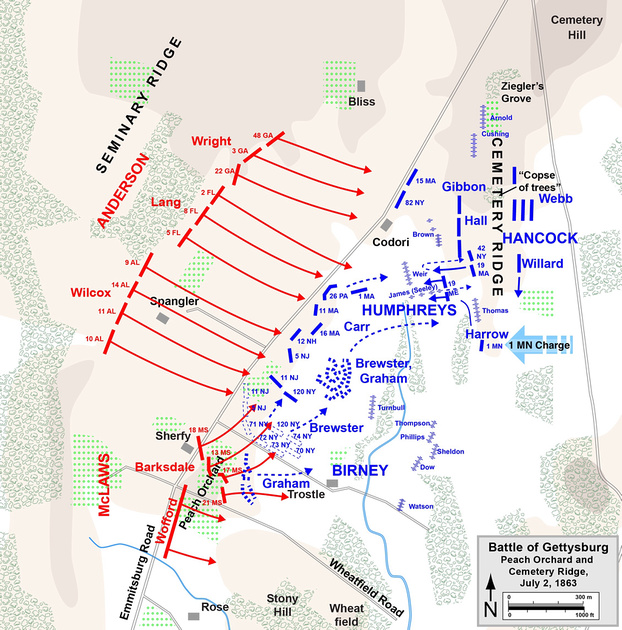
 As regiments from the Union Third Corps fall back from the Emmitsburg Road, the 1st Minnesota is ordered by General Hancock to stem the tide of the Rebel advance so as to bide time for the deployment of Willard's Brigade and other Union troops (Map courtesy of Wikipedia)
As regiments from the Union Third Corps fall back from the Emmitsburg Road, the 1st Minnesota is ordered by General Hancock to stem the tide of the Rebel advance so as to bide time for the deployment of Willard's Brigade and other Union troops (Map courtesy of Wikipedia)
General Hancock Wounded Monument
The small white building in the distant background is the Phillip Snyder farmhouse. At 3:00 pm on July 2, 1863, this farm area would serve as the launching point for General Longstreet's 1st Corps attack on the Union left. Later that day these troops would be fighting the 1st Minnesota at Plum Run near Cemetery Ridge.
Center: General Hancock Wounded Monument
Right Center: 14th Vermont Monument
Middle Background: Cordori Farm
Left Background: Virginia Monument with General Robert E. Lee Equestrian Statue - Approximate center point for Day 3 "Pickett's Charge"
Left Foreground: 2nd USSS Monument - Unit in which I spent 10 years doing Civil War Reenactment & Preservation Work
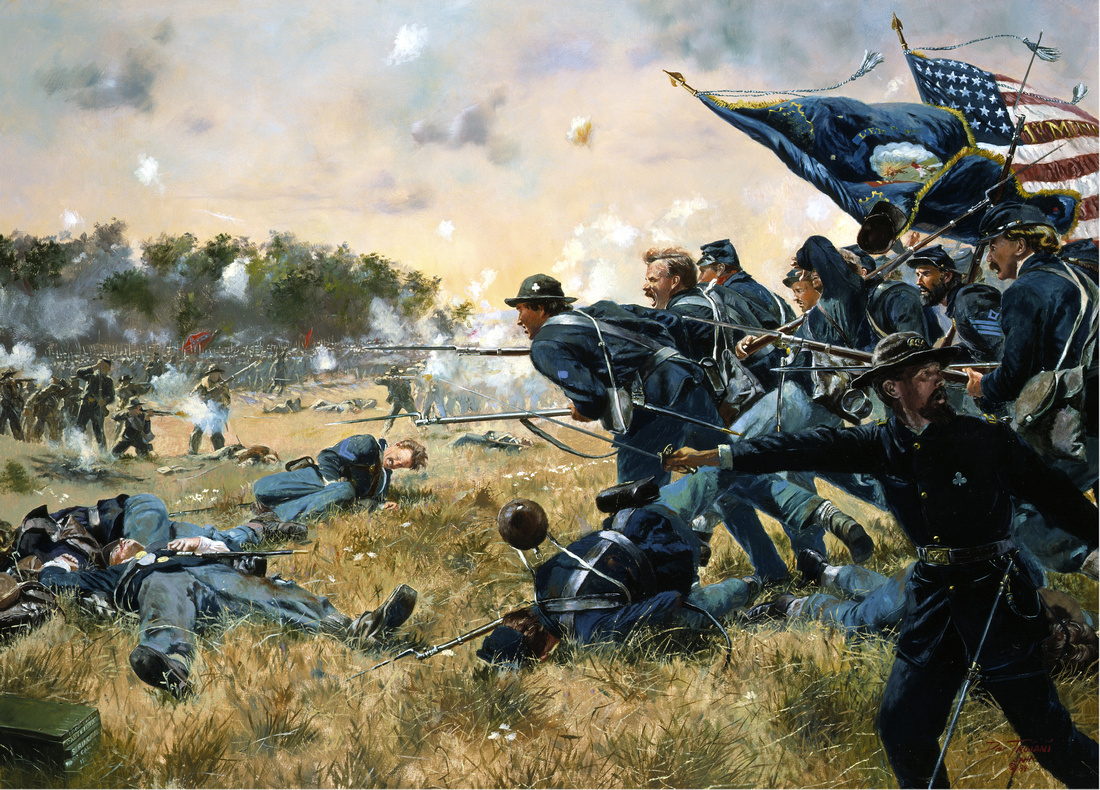
 The First Minnesota by Don Troiani depicting the famous charge at the Battle of Gettysburg
The First Minnesota by Don Troiani depicting the famous charge at the Battle of Gettysburg
